What are browser hijackers?
Browser hijackers are computer software that are downloaded onto your PC or laptop in a rather underhand way. In fact, you are normally at fault for downloading them, although to be fair, browser hijacker programmers don't make it that clear. In fact they are often downright sneaky about it. And that's because they know that you probably wouldn't choose their homepage over your regular default one, so they finagle their way onto your machine surreptitiously, in the hope that once it's there you'll either decide to keep it, or will be too lazy or ignorant to remove it.
How am I at fault for downloading and installing bing.vc?
Every single time you download a file or program, or upgrade an existing one, you could also be downloading something else with it –in this case the bing.vc browser hijacker. It usually finds its way on to our operating systems by being bundled with another product. So that must mean it is dangerous, right? Well although this obtrusive method of installation is a slight of hand, it doesn't mean that bing.vc and similar browser hijackers are necessarily harmful. They don't perform stunts like other malware, locking files, emptying bank accounts, stealing data etc. But that begs the question.
What is the point of bing.vc?
Surely no one is going to go to the trouble of designing and then sneakily installing a new home page or search engine provider purely for the fun of it? After all, what's in it for them? Well, unlike your regular homepage or search engine provider, bing.vc has been created to redirect internet searches to websites that the programmer wants to drive traffic to. Not only will the browser hijacker be more unwieldy to use and have fewer capabilities than your original one but it will continually fail to send you to the web page that you want to go to. And if you think the joke wears thin after, oh let's say the second time it happens, you'd be right!
How to make sure this doesn't happen to you
As mentioned, because it comes as a package, you need to be a lot more careful when you install software. Take the time to read License Agreements properly as the browser hijacker will be mentioned somewhere in the wording.
How do I remove bing.vc?
It can be a tedious task. It modifies browser settings and also makes modifications to Windows registry. Hopefully, the removal guide below will help you to remove this browser hijacker from your computer. If you have any questions, please leave a comment down below. Good luck and be safe online!
Written by Michael Kaur, http://deletemalware.blogspot.com
Bing.vc Homepage Malware Removal Guide:
1. First of all, download recommended anti-malware software and run a full system scan. It will detect and remove this infection from your computer. You may then follow the manual removal instructions below to remove the leftover traces of this infection. Hopefully you won't have to do that.
2. Remove bing.vc related programs from your computer using the Add/Remove Programs control panel (Windows XP) or Uninstall a program control panel (Windows 7 and Windows 8).
Go to the Start Menu. Select Control Panel → Add/Remove Programs.
If you are using Windows Vista or Windows 7, select Control Panel → Uninstall a Program.

If you are using Windows 8, simply drag your mouse pointer to the right edge of the screen, select Search from the list and search for "control panel".

Or you can right-click on a bottom left hot corner (formerly known as the Start button) and select Control panel from there.
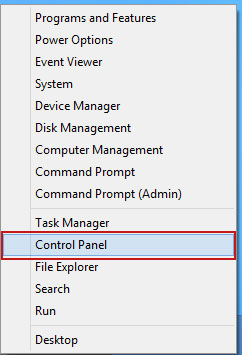
3. When the Add/Remove Programs or the Uninstall a Program screen is displayed, scroll through the list of currently installed programs and remove the following programs:
- bing.vc
- Go_bing.vc
- GoSave
- MuiTub
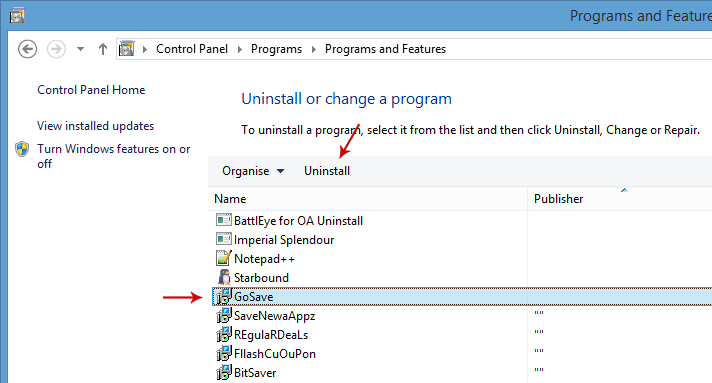
If you are using Windows Vista, Windows 7 or Windows 8, click Uninstall up near the top of that window. When you're done, please close the Control Panel screen.
Remove bing.vc from Google Chrome:
1. Click on Chrome menu button. Go to Tools → Extensions.
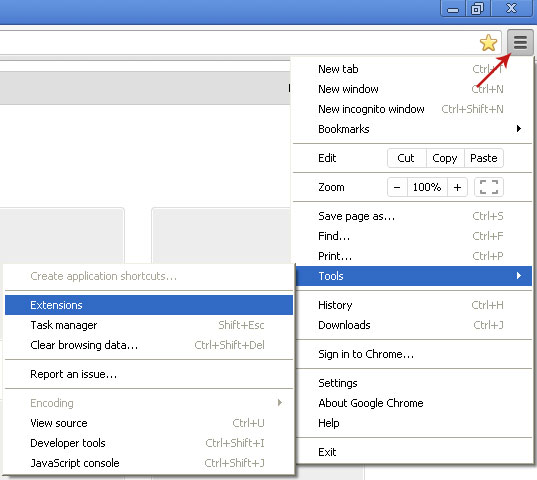
2. Click on the trashcan icon to remove bing.vc, MuiTub, BookmarkTube extensions.
3. Then select Settings. Scroll down the page and click Show advanced settings.
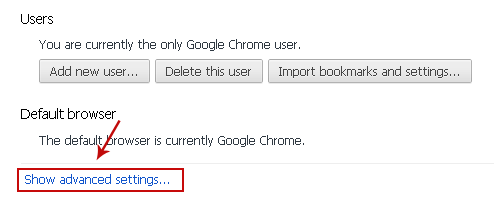
4. Find the Reset browser settings section and click Reset browser settings button.
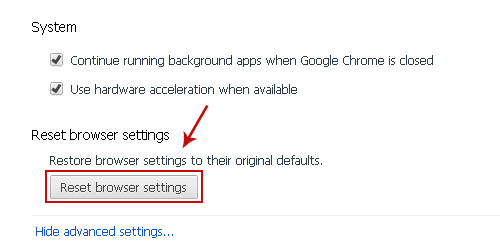
5. In the dialog that appears, click Reset.
6. Right-click Google Chrome shortcut you are using to open your web browser and select Properties.
7. Select Shortcut tab and remove "http://bing.vc/?r=15443&lnk=sct2" from the Target field and click OK to save changes. There should be only the path to Chrome executable file.
Remove bing.vc from Mozilla Firefox:
1. Open Mozilla Firefox. Go to Tools → Add-ons.

2. Select Extensions. Remove bing.vc, MuiTab, BookmarkTube browser extensions. Close Add-ons manger.
3. In the URL address bar, type about:config and hit Enter.
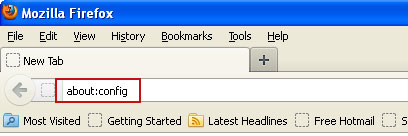
Click I'll be careful, I promise! to continue.

In the search filter at the top, type: bing.vc
Now, you should see all the preferences that were changed by bing.vc. Right-click on the preference and select Reset to restore default value. Reset all found preferences!
4. Right-click the Mozilla Firefox shortcut you are using to open your web browser and select Properties.
5. Select Shortcut tab and remove "http://bing.vc/?r=15443&lnk=sct2" from the Target field and click OK to save changes. There should be only the path to Firefox executable file.
Remove bing.vc from Internet Explorer:
1. Open Internet Explorer. Go to Tools → Manage Add-ons.

2. Select Search Providers. First of all, choose Live Search search engine and make it your default web search provider (Set as default).
3. Select bing.vc and click Remove to remove it. Close the window.
4. Right-click the Internet Explorer shortcut you are using to open your web browser and select Properties.
5. Select Shortcut tab and remove "http://bing.vc/?r=15443&lnk=sct2" from the Target field and click OK to save changes. Basically, there should be only the path to Internet Explorer executable file.
Remove Bing.vc Homepage Malware (Uninstall Guide)
4/
5
Oleh
soni agus


